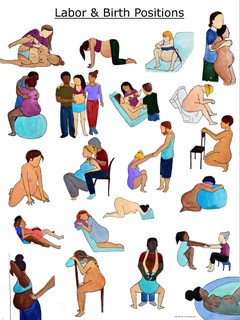Positions in Labour
When the big day is nearing your mind begins to turn to how are things going to go in labour. In a previous blog we talked about pain relief in labour. One of the things we mentioned was that different positions can provide relief from certain types of labour pain. So now we are going to look at what those positions might be, when they are most effective, and how they affect the positive progress of your labour.
Fast and Furious
We might think we want to get labour over and done with quickly because we know that it will hurt. But in reality, labour will take as long as it takes, and there are some risks to a very quick labour, not least of which is serious tearing. So what we should be aiming for is strong, steady progress – not a fast and furious race to the finish line.
Early Labour
Generally, you are considered to be in early labour until you are around 3cm dilated, and the mantra here is really, rest, eat, sleep, repeat.
Rest – getting some rest to ensure you have the energy to get through the next phases of labour can be a good idea. The best position here is to lie on your side with your top leg bent and a pillow between your knees. If the contractions aren’t too strong, try and get a little sleep, or meditate.
Eat – aim for something light and nutritious. Try and avoid heavy meals, it’s best to snack. And remember to stay hydrated.
Move – gravity is your best friend in labour, so try to keep moving, Walking – even dancing – will help move put pressure on your cervix, speeding up your dilation and helping the baby get into the right position.
Generally, unless you have a very quick labour, you will have plenty of time for a bit of all three, which is the ideal.
Active Labour
From about 3 to 10cm is known as Active Labour. This is where things really start to ramp up. The aim here is to get the baby into the right position, make sure your contractions are nice and strong, and open your pelvis so the baby doesn’t have too tough a time moving through the birth canal.
There are lots of positions here that will help with all three goals:
- Upright – as in Early Labour, the weight of the baby will help efface the cervix. If the contractions are strong, lean up against your partner, a wall or a piece of furniture. But try to stay as upright as possible, especially in between contractions.
- Hands and Knees – this position helps move the baby to the anterior position if it is in the posterior position, and can provide some relief from lower back pain, It also means you are in a good position for back massage, hot and cold packs. And it allows you to move – swaying to music can be good – all of which help labour progress at a steady pace.
- Kneel or Squat – this allows you to drop the weight of your belly on your legs, but remain upright – there’s that gravity again!
- Sitting – on a bed or a ball. Sitting cross legged on a bed allows you to rest your belly. Rocking on a ball is good. If you are on a ball, make sure you have someone to support your stability during contractions.
- Moving – particularly between contractions, if you can pace, rock or slow dance supported by your birth partner, it will help open your pelvis and allow the baby to move down.
Second Stage – Pushing and Birthing
You will most likely be tired, but if you can get on all fours and keep that pelvis open things will move more quickly. If you don’t think you can manage that, at least try to sit upright, kneel or squat. I can’t stress enough how much gravity will help from beginning to birth!
Sometimes, particularly in hospital births, you will be encouraged to move to what is called a supine position for birth. This means lying down on your back. Whilst this is in some ways the most convenient position for the midwives and doctor, it is not the most efficient position for mum and baby. In fact, in this position, the birth canal curves upwards, so you are fighting against that gravity we have talked about, To see how the baby moves through the pelvis, watch this video: https://www.facebook.com/colchesterbirth/videos/1773156409409529/
Don’t be afraid to speak up and tell your attendants what you would prefer. They will always let you know if there is a medical reason why it’s not a good idea.
What to Try and Avoid
Birth is a very personal experience, and ideally a labouring mum should be able to choose how she approaches it, providing there are no dangers to mum or baby.
However, there is one position, often preferred in hospitals, that should be avoided if possible. The World Health Organisation, in the publication ‘Care in Normal Birth’ says that “women in labour should be allowed to adopt any position they like, while preferably avoiding long periods of lying supine”.
When you lie on your back the weight of the baby can restrict mum’s blood flow, potentially reducing your oxygen, and as mentioned earlier, the upright tilt of the birth canal in this position will show things down. Gravity really is the single most effective tool you can use during your labour.
Always remember…
This is your birth, your body and your baby. Don’t be afraid to tell people what you want and need.
If you would like to talk about the sort of birth you would like, or what benefits a doula can bring to your birthing plan, please get in touch and we can have a chat about your birthing dreams:
